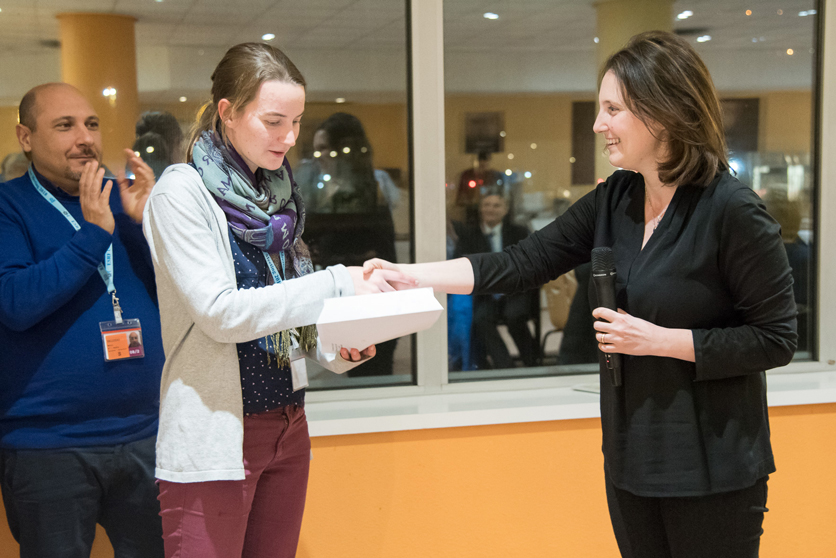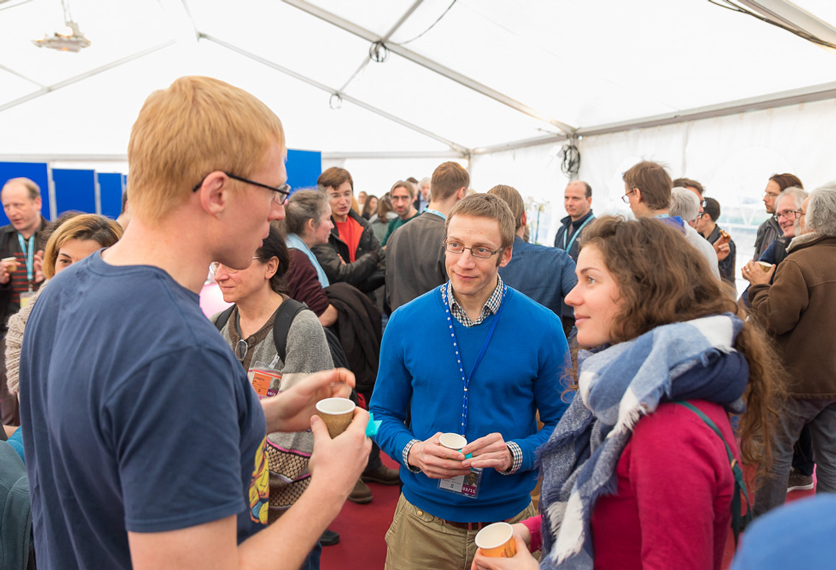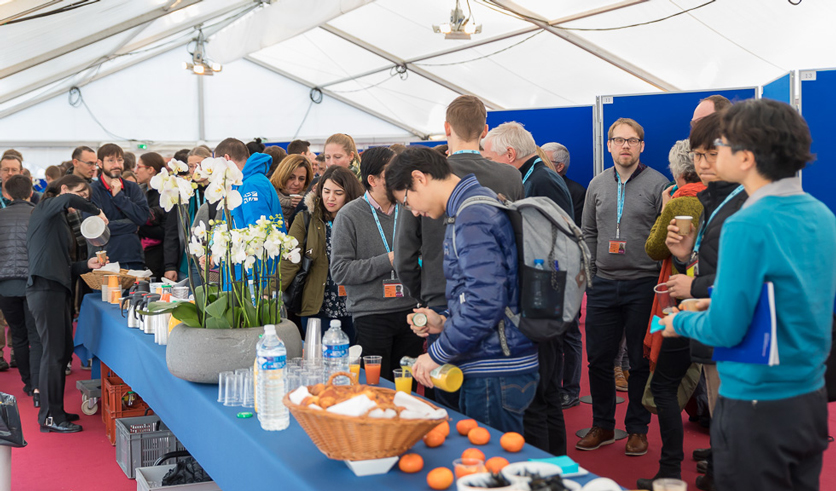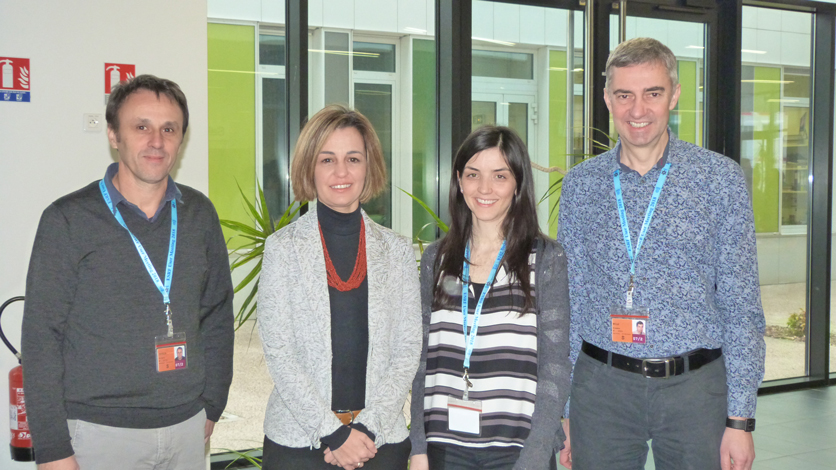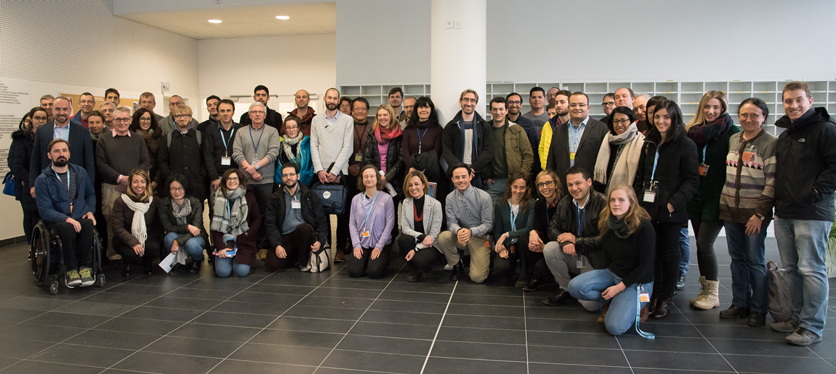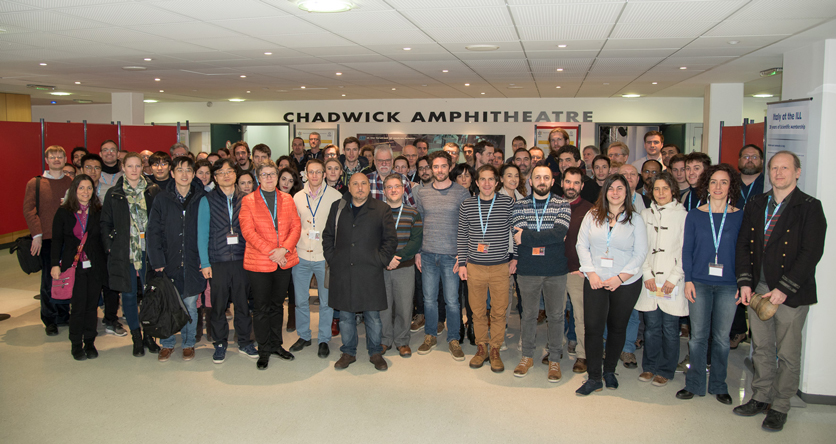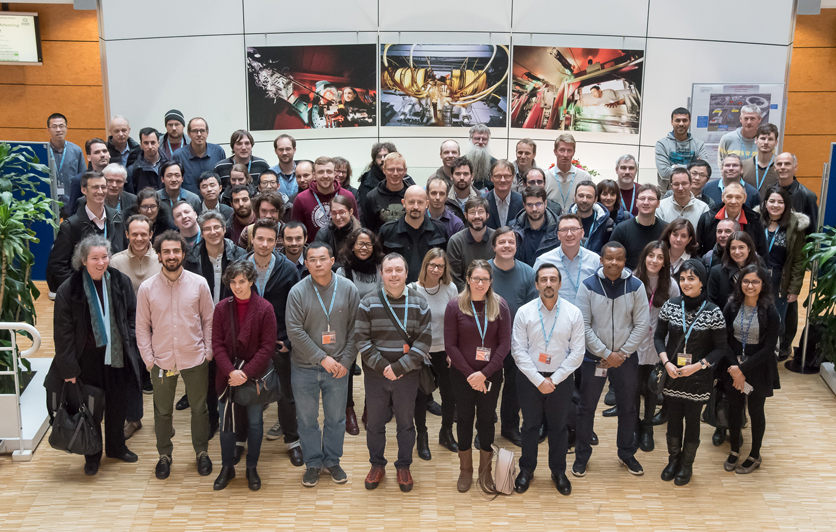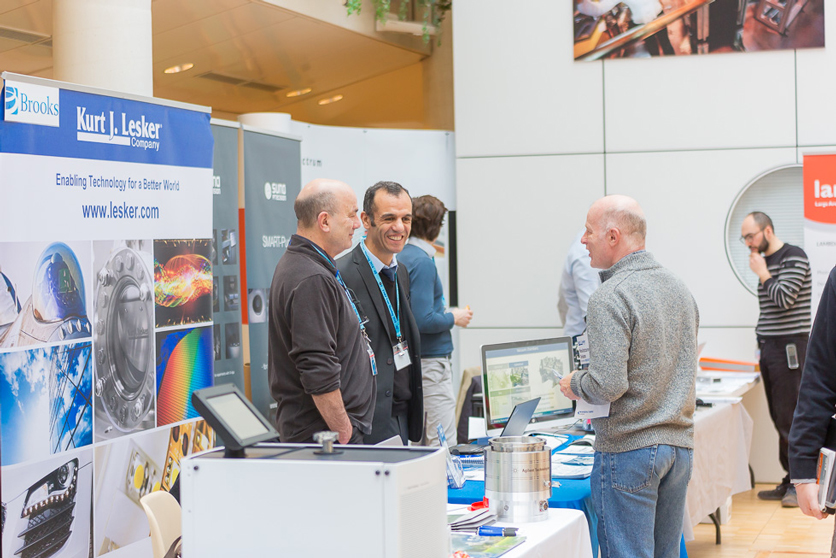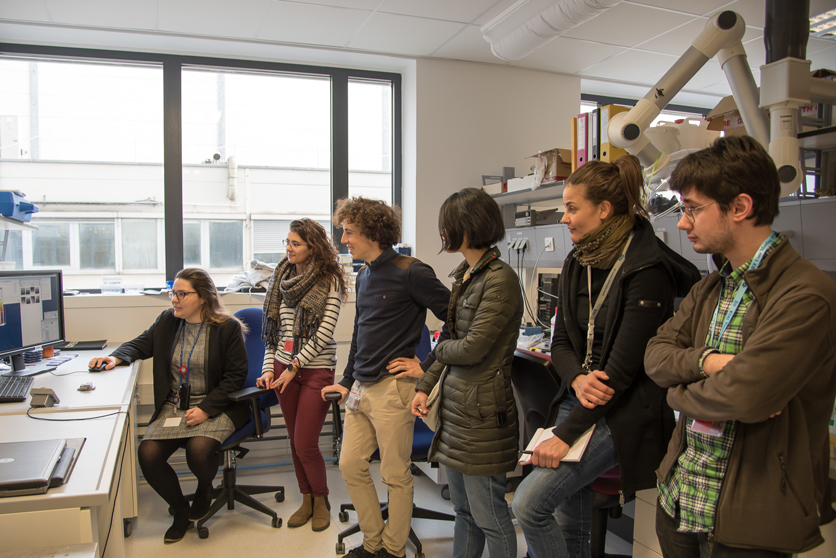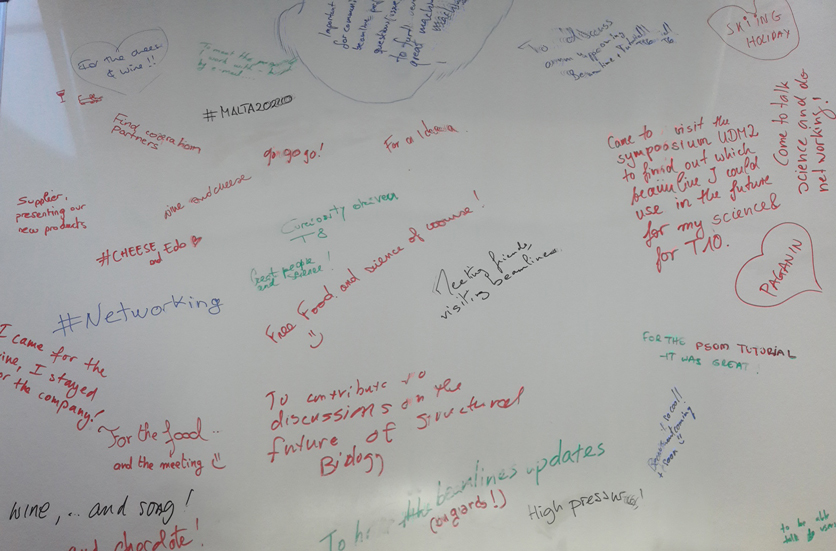- Home
- News
- General News
- UM2018: Silja Flenner...
UM2018: Silja Flenner wins Best Poster Award
06-02-2018
Silja Flenner was awarded the prize for best poster at the User Meeting dinner on Tuesday, 6th February. Her poster presents research into the structure and function of the small hairs found on spider feet, using scanning X-ray nanobeam diffraction and small angle scattering.
Main photo: Silja Flenner explains her research in 90 seconds during the UM2018 Poster Clips. ©ESRF/P. Jayet
Spider attachment hairs have outstanding adhesive properties that allow these creatures to walk upside-down on rough and smooth surfaces while carrying a multiple of their body weight. Spider feet are covered with thousands of specially designed hairs that have spatula-shaped tips made of composite material consisting of proteins and chitin fibres. The aim of Silja’s research is to reveal the structure-function mechanism of these hairs.
This research could be used, for example, to improve the longevity and efficiency of artificial sticky tapes or in the development of wall-climbing robots.
Looking to nature for innovation
“When I started this research, synthetic products based on the adhesiveness of spider feet already existed, for example the so-called “gecko tape”. However, the longevity of these synthetic products is still largely inferior to what is produced in nature. In this research, we are trying to see what in the structure of the hairs makes these natural systems stable for longer,” says Silja.
Silja Flenner, 26, is in the first year of a PhD at the Helmholtz-Zentrum Geesthacht, Centre for Materials and Coastal Research, in Germany. She first came to the ESRF for beamtime in 2015 and has been back several times since, working with the ESRF team on ID13. “The research has evolved from looking at the tip of the attachment hair to focussing today on the hair shaft. We’ve seen that the structure of the shaft changes depending where on the spider’s foot it is located.”
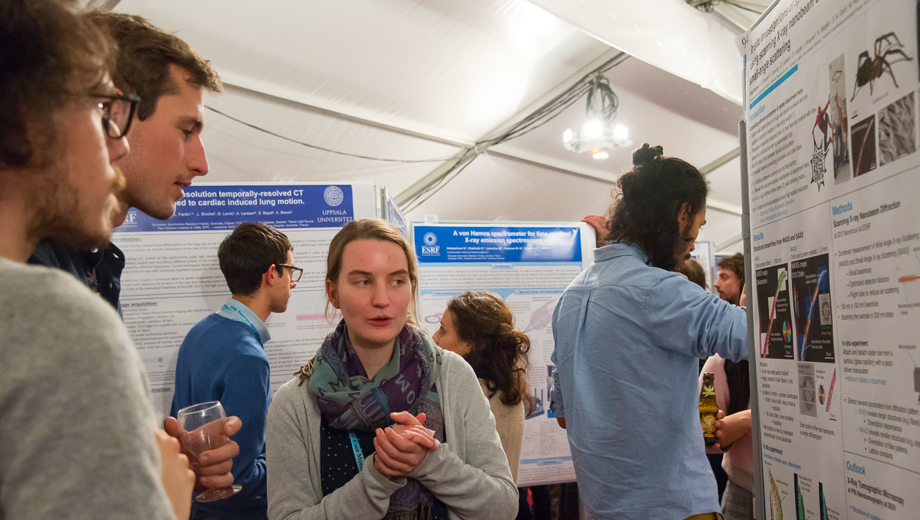 |
|
Silja gives more information to fellow users during the Poster Session ©ESRF/C. Argoud |
“I was surprised to receive the best poster prize at the ESRF and I’d like to thank all the beamline staff at ID13 for their support during my experiments here. Thanks, too, to my professor, Martin Müller, and to the biologist, Clemens Schaber, for giving me the opportunity to work on this exciting topic,” says Silja.
It’s Silja’s first time at the ESRF User Meeting and she hopes to become a regular in the coming years. “I learned a lot during the tutorial on tomography on Monday (T6) and what I really appreciate is that the meeting is well-scaled to allow you to see all the posters on show and have time to discuss with ESRF staff and other users. Thanks to the organisers for such a great event,” concluded Silja.
Wednesday, day 3 of the User Meeting is centred around the three User Dedicated Microsymposia (UDM), each with keynote lectures and talks from users from around the world.
The User Meeting is also an interesting venue for many commercial exhibitors who can present their latest innovations and products to the specialised audience of the event.
The poster session on Tuesday evening also gave rise to another wave of inspiration from participants when asked the question: What's on your mind? One, two or three words to describe UM2018.
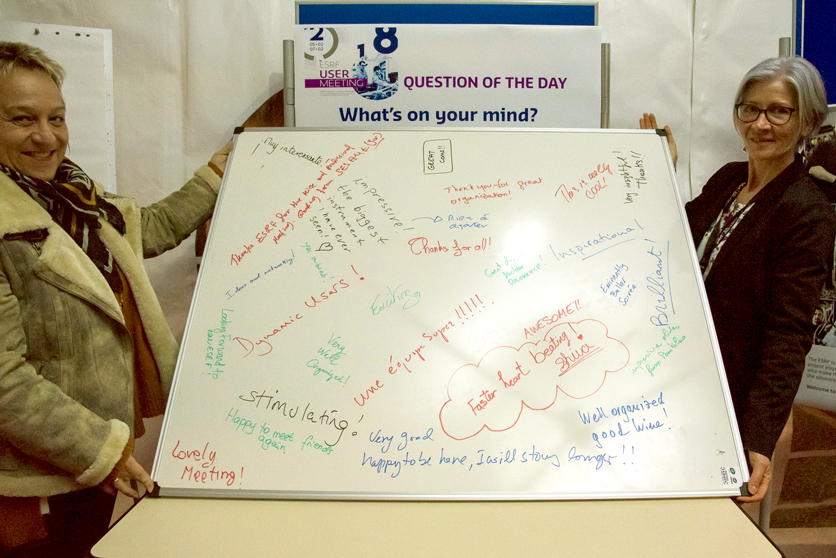 |
|
Users told us how they felt about UM2018 ©ESRF/C. Argoud |
News from earlier in the meeting
Tuesday, 6th February, 2018
UM2018 is in full swing: tutorials, plenary session, poster clips!
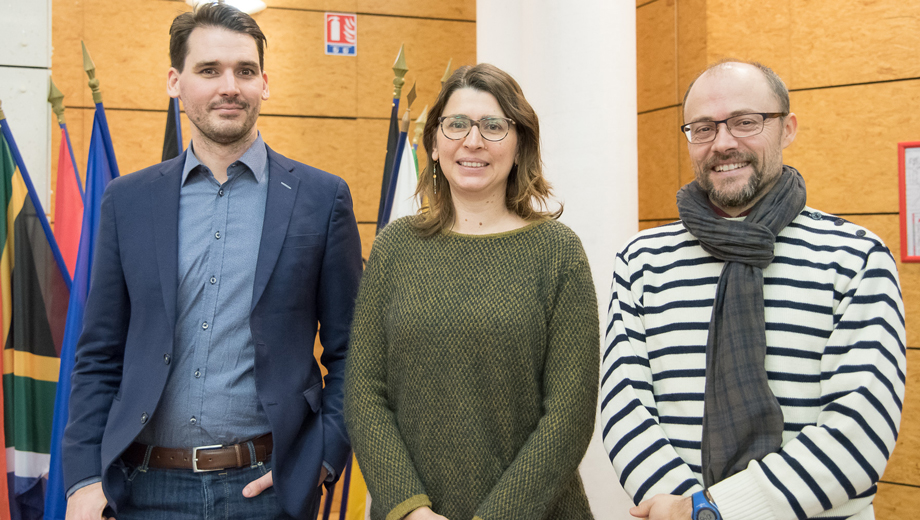 |
|
The three keynote speakers of the Plenary Session, from left to right: Hugh Simons, Virginie Chamard and Jérôme Rose. ©ESRF/C. Argoud. |
"Welcome everyone to the 28th ESRF User Meeting," said Paola Coan, head of the User Organisation. "Despite its great age, the User Meeting has maintained a dynamic and diversified programme and participation is on the rise this year."
Paola Coan continued her introduction to the meeting by recalling the successful year 2017 for the ESRF in terms of user popularity: the record number of proposals received and the record number of users coming on site was the most obvious sign of an active user community. She saluted the original ESRF storage ring that has served for the last 20 years and acknowledged the excellent science that has been produced in that time. “2018 also marks the end of an era for the original storage ring, as well as the beginning of a new era with the realisation of EBS, the first of a new generation of storage rings, and also the construction of new state-of-the art beamlines and an ambitious instrumentation programme." She evoked the tremendous task that lay ahead for the ESRF and confirmed the confidence of the User Organisation in the successful achievement of EBS.
Paola Coan launched the plenary session. The first keynote speaker, Virginie Chamard from the Institut Fresnel, CNRS, at the Aix-Marseille University, took the floor to talk about new X-ray microscopy techniques developed over the last few years and which can be used to shed new light on biomineralisation techniques.
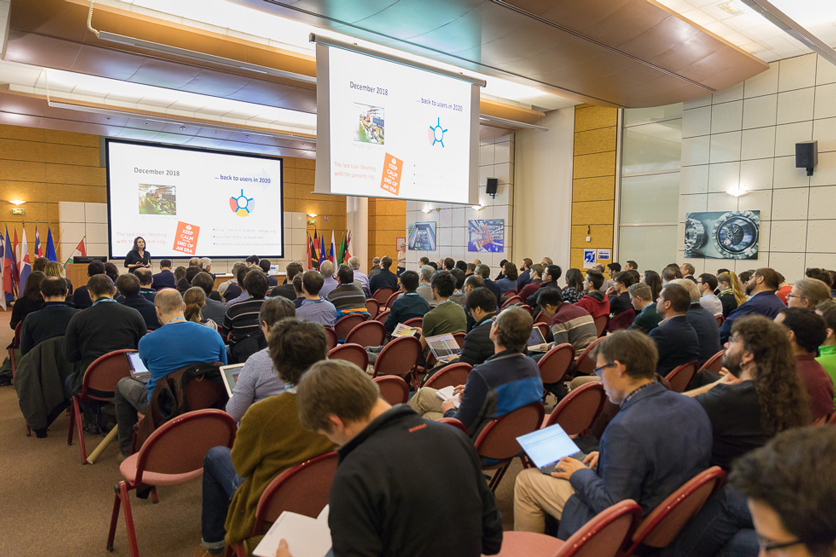 |
|
2020 will mark the beginning of a new era with the world's first-of-a-kind generation of synchrotron: EBS. During the introduction to the Plenary Session on 6th February. ©ESRF/P. Jayet |
The Plenary Session continues throughout the day with two further keynote lectures by
- Hugh Simons, Technical University of Denmark, Department of Physics, Lyngby, Denmark
- "Real-time 3D imaging of multi-scale material dynamics", and
- Jérôme Rose, Université Aix-Marseille III, Aix-en-provence, France
- "Nanotechnologies risk assessment: exposure and product life cyle driven methodology"
Before lunch, the Directors' report will include presentations on the final three beamlines upgraded during Phase I, followed by a session dedicated to EBS with updates on the status of the machine, experimental programme and enabling technology programme. Then come the poster clips and one of the highlights of the day: the Young Scientist Award 2018.
The poster session will start at 17:40 and the winner will be announced during this evening's dinner.
What else has been happening at UM2018?
Flashback to Monday, when day 1 of the User Meeting saw the participants spread across the site of the EPN Campus, with 11 different tutorials on offer.
Over in the Science Building, the Partnership for Soft Condensed Matter (PSCM), opened the doors of its laboratories to show the facilities available, providing users and future users with a hands-on first approach to equipment and techniques.
“At the PSCM, we have around 60 instruments, half of which are major and can be booked online. They are available to all users and onsite staff for the preparation and characterisation of samples to be measured on the ESRF beamlines or using the neutrons at the ILL,” says Diego Pontoni, one of the tutorial organisers. For groups with a special interest in the facilities and seeking a long-term collaboration, it is possible to set up partnerships that include office/lab space and support for the development of new sample environments or tools.
Interested? Contact the PSCM (pscm-support@esrf.fr) for more information.
The day concluded with the traditional bistrot evening in the marquee. While exchanging on science and enjoying the fine selection of local meats, cheeses and wines, we asked users why they had come to UM2018. Here's some of the replies we received :
|
|
"I've come to visit the symposium UDM3 to find out which beamline I could use in the future for my science. And also for Tutorial T10 (Laue Microdiffraction)." "Meeting friends, visiting beamlines.""To contribute to discussion on the future of structural biology." "Great people and science!" "I came for the wine, I stayed for the company!"
|
|
"To discuss on upcoming beamtime and tutorial T6 (Volume image analysis of tomographic data)." "Come to talk science and do networking!" "It's an important opportunity for communication about beamline performance, user guestions/issues, and plans to further develop this great machine." |
"Because it's so cool and I have an experiment coming soon!" "To be able to talk to users." "To find cooperation partners." "Curiosity driven, and for Tutorial T8 (Nuclear resonance applications)."
|
Monday, 5th February, 2018
ESRF 2018 User Meeting welcomes over 380 participants.
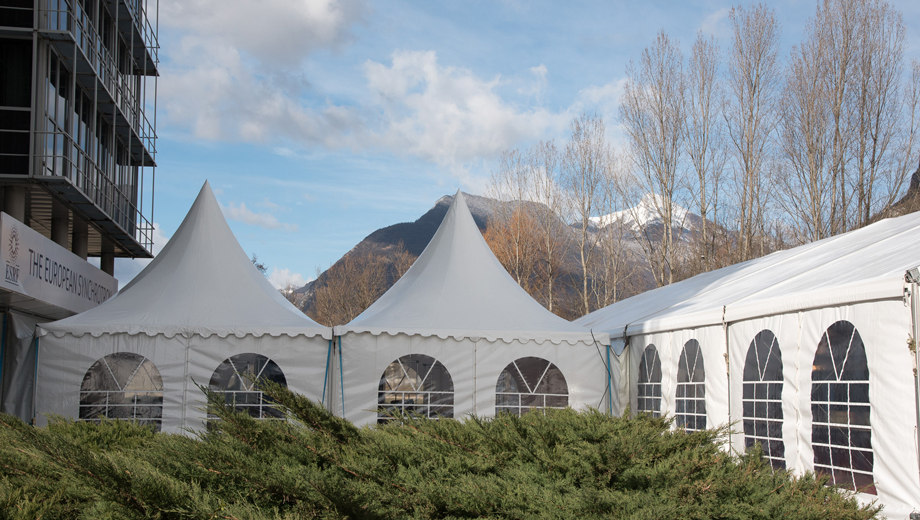
It’s that particular time of the year again when the ESRF opens its doors for 3-days of extra-special time with our users. From 5-7 February 2018, the ESRF will bring together more than 380 members of the synchrotron community for lively discussions, tutorials, keynote lectures, dedicated symposia, poster clips and social events.
Diversity is a key word at the ESRF and this year's User Meeting is no exception with participants coming from 28 different countries and totalling 48 different nationalities between them.
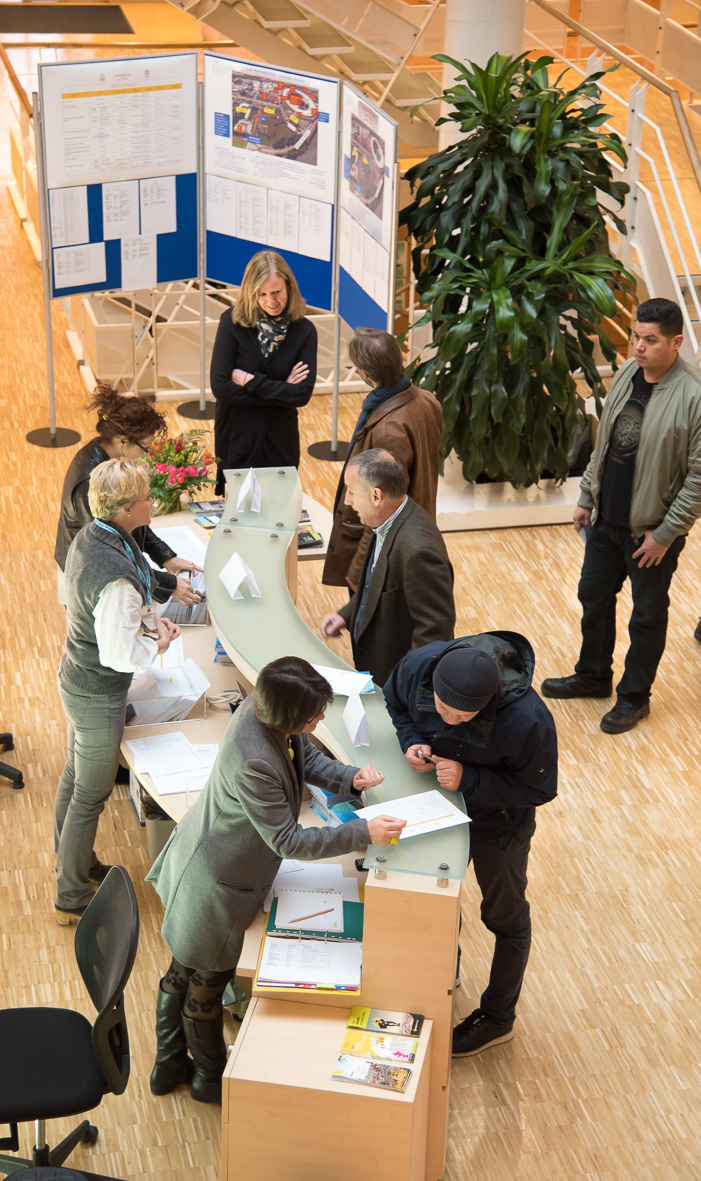 |
|
During 1st day registrations at the ESRF User Meeting 2018. |
The User meeting is an excellent opportunity to learn more about the exciting science taking place at the ESRF today but also to learn what kind of science will be made possible with EBS - the Extremely Brilliant Source - which will be in operation from 2020.
“One of the aims of the ESRF User Meeting is to attract young users and to inform and train them in more detail about synchrotron techniques and data treatment. It also offers these young users the opportunity to talk about their research and present their data to the community,” says Joanne McCarthy, head of the ESRF User Office.
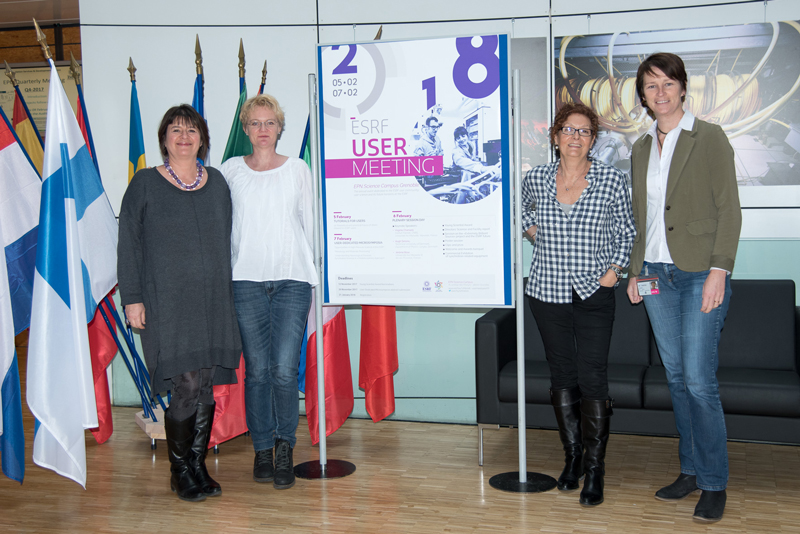 |
|
Welcome Users! The team from the User Office as they finalised the last minute preparations for the UM2018. Left to right: Nadine Petricola, Sonya Girodon, Agnès Carlet and Joanne McCarthy. ©ESRF/C. Argoud. |
The plenary session, which will take place all day on Tuesday, 6th February will include a dedicated session on the Extremely Brilliant Source project (ESRF-EBS). It also includes keynote lectures from:
- Virginie Chamard, Institut Fresnel, CNRS, Université Aix-Marseille, Marseille, France
- "Deciphering biomineralization pathways with a new X-ray Bragg microscopy"
- Hugh Simons, Technical University of Denmark, Department of Physics, Lyngby, Denmark
- "Real-time 3D imaging of multi-scale material dynamics"
- Jérôme Rose, Université Aix-Marseille III, Aix-en-provence, France
- "Nanotechnologies risk assessment: exposure and product life cyle driven methodology"
On Wednesday, three user-dedicated micro-symposia will be held with the following topics:
- Opportunities in High Pressure Science at the ESRF
- Metallurgy and Materials Processing
- Understanding Neurological Diseases: Synchrotron Science in a Multidisciplinary Approach
The symposia will include talks from users in the related disciplines. In addition, each user-dedicated micro symposium will host keynote talks and the opportunity to meet and discuss with the ESRF staff.
Monday’s events include 12 different tutorials. The day will end with the traditional wine and cheese bistro evening.
Get the full programme on the User Meeting web pages.
Follow the activities of the 2018 ESRF User Meeting on Facebook, Twitter and Instagram.
If you are tweeting at the meeting yourself, don’t forget to add the hashtag #UM18
Text by Kirstin Colvin
